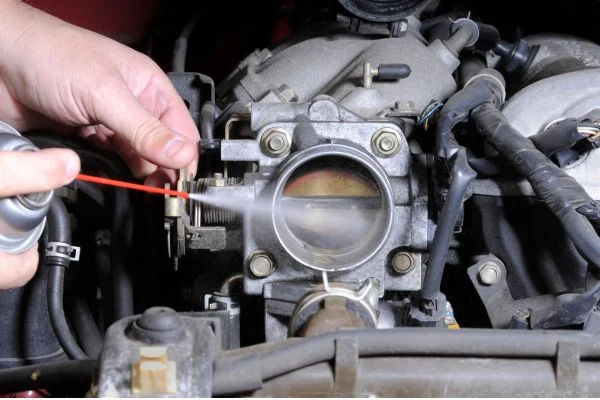Electronic throttle bodies are an integral part of modern vehicles, controlling the amount of air entering the engine in order to maintain the optimal air/fuel mixture. Testing an electronic throttle body with a multimeter is a great way to diagnose any issues that may be causing the throttle body to fail. Before testing throttle body ensure you the best automotive multimeter. Learn how to test electronic throttle body with multimeter in this guide.
What Is A Throttle Position Sensor?
Throttle position sensor (TPS sensor), also known as the throttle valve position sensor or throttle valve position sensor, is a part of the electronic throttle control system and is connected to the throttle body of your vehicle and monitors the angle at which the throttle valve is opened and closed.
What Does It Do?
You’re probably wondering what the throttle does. The throttle body in your car is located between the air cleaner and the intake manifold of the engine. It features a butterfly valve (throttle opening) that regulates how much air gets into the engine, which in turn helps the engine to produce more power.

With a throttle sensor, you can check the function of your throttle. It is a potentiometer that gives a variable resistance based on the angle at which the throttle valve is opened. When a wide open throttle valve (WOT) is applied, the sensor sends a signal voltage (output voltage) to the ECU of your car of approximately 4.5 volts.
Symptoms Of A Faulty Throttle Position Sensor
Vehicles’ electronic fuel injection systems depend on the throttle position sensor (TPS), which relays information about the throttle position to the Engine Control Unit (ECU) as part of their electronic fuel injection system.
A malfunctioning throttle position sensor can affect the vehicle’s performance and efficiency in a variety of ways. Here are some symptoms associated with a malfunctioning throttle position sensor:
1. Decrease in Fuel Economy
A faulty TPS can lead to inaccurate readings of the throttle position, which can lead to incorrect adjustments in the air-fuel mixture. Therefore, the engine may receive either too much or too little fuel during combustion. As a result of this imbalance, fuel economy can be noticeably reduced. Drivers may need to refuel more frequently as a result.
If your car fuel pump relay have faulty check How to Test a Fuel Pump Relay With Multimeter? Click Here
2. Sudden Idle Surges
Symptoms of malfunctioning TPS include irregular idle behavior. Rather than maintaining a steady and consistent idle speed, the engine will fluctuate suddenly in RPM (revolutions per minute). The engine control system struggles to regulate the idle speed when the TPS sends irregular signals to the ECU.
3. Sudden Surges in Speed
The TPS can also cause unpredictable surges in the vehicle’s speed even when the throttle input is kept constant. When the driver is not expecting or prepared for such a sudden acceleration, it can be dangerous. The TPS’s inability to transmit accurate throttle position information can disrupt the delicate balance between the engine’s power delivery and the driver’s control.
4. Hesitation While Accelerating
Among the critical functions of the TPS is to relay information about the throttle position in real time to the ECU, which then adjusts the fuel injection and ignition timing accordingly.

During acceleration, the TPS might send incorrect signals if it is faulty, causing hesitation or stumbling. When the driver presses the accelerator pedal, the vehicle usually feels hesitant for a moment, followed by a sudden burst of acceleration. A driver’s confidence on the road can be affected by this inconsistency.
5. Rough Idling
It is possible to experience rough idling if the TPS malfunctions. In this case, the engine will exhibit an uneven and unstable rhythm when running at idle speed. If the throttle position is incorrectly read, the air-fuel mixture and ignition timing are not adjusted properly, which causes rough idling.
How To Test Electronic Throttle Body With Multimeter | Step By Step Guide
You should know how to test electronic throttle body with multimeter. Testing your throttle position sensor (TPS) can help diagnose potential issues with your vehicle’s engine performance. A malfunctioning TPS can lead to problems like poor fuel efficiency, rough idling, or difficulty in acceleration. Here’s a step-by-step guide on how to test your TPS using a multimeter.
Step#1. Cleaning the Throttle

If you want to test the throttle position sensor (TPS), you will first need to clean the throttle body. If the throttle body is dirty, it can affect the readings from the TPS. Use a throttle body cleaner to remove debris and carbon buildup on the throttle body.
Step#2. Locating the Throttle Position Sensor Grounding
One of the wires on the wiring harness connected to the TPS will be the ground wire for the sensor, which is typically black or brown and is located on the throttle body. Once you identify the wiring harness connected to the TPS, you can locate the wire’s ground.
Step#3. Setting the Multimeter to DC Voltage Mode
The voltage supplied by the TPS can be measured by switching your multimeter to DC voltage mode. This mode allows you to read the voltage passed from the TPS.
Step#4. Probing the Throttle Position Sensor
In the “On” position of the key (engine not running), back probe the signal wire of the TPS. This wire is commonly color-coded in green or blue. Insert the positive (red) probe of the multimeter into the terminal of the signal wire.
Step#5. Finding the Reference Voltage Terminal

There is a wire called the reference voltage wire, which is responsible for supplying a constant voltage to the TPS. The wire may be color coded in 5V (volts) or it may be orange or red in color. Insert the negative (black) probe of the multimeter into the terminal of the reference voltage wire.
Step#6. Re-adjusting Your Multimeter to 10 DC Voltage
As part of the calibration, be sure to set the multimeter to read at least 10 volts. This will ensure that the reference voltage is measured accurately. There are some multimeters that have an auto-range feature, but many require manual adjustment of the range.
Step#7. Checking the Reading
In order to confirm that the voltage is around 5 volts, you have to insert both probes into the TPS, and observe the reading on the multimeter. If it is significantly different, there could be an issue with the power supply to the TPS.
Step#8. Testing the Signal Return Terminal
The positive probe should be kept in the signal wire terminal and the negative probe should be moved to the sensor’s ground wire terminal. Slowly press the throttle pedal back and forth from fully closed to fully open while observing the voltage reading on the multimeter.
- At closed throttle, the voltage should be close to 0.5 volts.
- As you slowly open the throttle, the voltage should increase smoothly.
- At wide-open throttle, the voltage should be around 4.5 to 5 volts.
Any sudden jumps, drops, or erratic behavior in voltage can indicate a faulty TPS that needs replacement. Remember that specific vehicle models may have slightly different voltage ranges, so consult your vehicle’s manual or service information for precise values. Now you know, how to test electronic throttle body with multimeter?
Universal Throttle Body sensors
Precautionary Tips for Testing an Electronic Throttle Body with a Multimeter
- Safety First: Ensure the vehicle is parked in a well-ventilated area and the engine is turned off before starting any testing procedures.
- Disconnect the Battery: To avoid electrical mishaps, disconnect the vehicle’s battery before working on the throttle body or any electrical components.
- Use Proper Tools: Select a multimeter suitable for automotive use, and make sure its settings are appropriate for DC voltage measurements.
- Wear Safety Gear: Consider wearing safety goggles and gloves to protect your eyes and hands during the testing process.
- Avoid Short Circuits: Be cautious not to touch the multimeter probes together, as it can cause a short circuit and damage the meter.
- Handle Wires Carefully: Handle the wiring and probes gently to prevent damage to the vehicle’s electrical system.
FAQs
What is the voltage of the throttle body position sensor?
The voltage of the throttle body position sensor typically ranges from 0.5 to 1.0 volts at idle, rising to 4.0 volts (or more). The voltage output is dependent on the amount of throttle opening, with a higher voltage indicating a larger opening. This voltage is used by the vehicle’s computer to adjust the throttle position accordingly.
What sensors affect the throttle body?
The throttle body is affected by two sensors: the throttle position sensor (TPS) and the mass airflow sensor (MAF). The TPS measures the throttle position and sends a signal to the vehicle’s computer, while the MAF measures the amount of air entering the engine and adjusts the throttle position accordingly.
Can a dirty throttle body affect throttle response?
Yes, a dirty throttle body can significantly impact throttle response. When the throttle body becomes coated with carbon deposits or other debris, it can restrict the airflow into the engine. This restriction leads to reduced air intake and disrupts the air-fuel mixture balance, resulting in poor throttle response
Ending Point
The use of a multimeter as a means of testing an electronic throttle body is therefore crucial to the maintenance of the engine in your vehicle to ensure that it is operating at its optimum level. The throttle position sensor (TPS) and its associated components can be effectively assessed if you follow the step-by-step guide outlined earlier.
When the throttle body is cleaned, grounding and reference voltage terminals are identified, and a multimeter is used to measure voltage readings, this will provide valuable insights into the sensor’s functionality. We hope now you know, how to test electronic throttle body with multimeter.






